Trying to decide between the 6.5 Grendel and .308 Winchester cartridges? Here’s what you need to know about them.
While most hunters are probably familiar with the .308 Winchester as a hunting cartridge, the 6.5 Grendel is not nearly as well known or as widely used. However, as the AR-platform continues to gain in popularity among hunters and shooters, things are changing fast on that front as more people are looking into good cartridges to use in a Modern Sporting Rifle.
That’s not really surprising because the AR-platform offers many inherent advantages for hunters.
For that reason, hunters have several mainstream choices for medium bore AR cartridges. Among those that will function in an AR-15, the 6.5 Grendel is one of the most widely used. Likewise, the .308 Winchester is far and away the most popular cartridge used in the larger AR-10 platform. Both cartridges are solid performers, but each also has different strengths and weaknesses.
In this article, I’m going to do a detailed comparison of the 6.5 Grendel vs .308 Winchester and discuss the pros and cons of each one to help provide some insight into which cartridge will work best for you.
Before we get started, I have two administrative notes:
Some of the links below are affiliate links. This means I will earn a small commission (at no extra cost to you) if you make a purchase. This helps support the blog and allows me to continue to create free content that’s useful to hunters like yourself. Thanks for your support.
Finally, I recorded an entire podcast episode on this exact subject. If you’d rather listen than read, click the appropriate link below to listen to this episode on your preferred podcasting service.
6.5 Grendel vs 308 Winchester Podcast
Apple | Google | iHeart | Pandora | Spotify
History Of The 6.5 Grendel & .308 Winchester
Winchester unveiled the cartridge we now know as the .308 Winchester in 1952.
The result of a long and contentious search by the U.S. military for a new cartridge to replace the .30-06 Springfield after World War II, the new .30 caliber Winchester cartridge (and the very similar 7.62x51mm NATO cartridge the military adopted) had almost exactly the same ballistics as the original .30-06 load.
However, the newer .308 and 7.62x51mm cartridges fit this same performance into a significantly smaller package than the .30-06.
Specifically, the original 7.62x51mm NATO M80 ball load fired a 146 grain full metal jacket (FMJ) bullet at 2,750 feet per second (2,469 foot pounds of muzzle energy). The 7.62x51mm NATO had virtually the same ballistics as the original .30-06 Springfield load (150 grain bullet at 2,700 feet per second). Like the .30-06, the .308 Winchester and 7.62x51mm NATO fired a .308″ bullet.
The 7.62x51mm and the .308 Winchester both achieved that performance with a much shorter case (51mm vs 63mm) due to advances in powder technology that occurred after the development of the .30-06.
Though the .30-06 remains quite popular among big game hunters, the .308 Winchester has steadily grown in popularity over the ensuing decades as well and is now also one of the most popular and commonly used centerfire rifle cartridges in the world.
Now let’s talk about the 6.5 Grendel.
The M-16 rifle and 5.56x45mm NATO cartridge got off to a pretty rough start in Vietnam with the U.S. Army and Marine Corps. Modifications to the rifle and ammunition solved most of the problems that plagued the system during the war, but large numbers of people in the U.S. military still had very serious concerns regarding the stopping power of the diminutive cartridge.
Civilian hunters who adopted the AR-15 and .223 Remington cartridge during the last couple decades of the 20th Century shared those concerns. While the rifle and cartridge worked extremely well for target shooting and predator/varmint hunting, the .223 Remington developed a reputation for poor performance on deer sized game.
However, the AR-15 platform offered a number of advantages to shooters and was also very popular in the United States. With this in mind, gun designers with their finger on the pulse of the American hunting and shooting communities realized that they were looking at a potentially massive opportunity.
Realizing that many people loved the AR-15, but the .223 Remington cartridge was not the best choice for hunting big game, designers set about developing a number of larger bore cartridges that were more powerful than the .223 Remington, but would still function in AR-15 rifles.
Among others, this list includes cartridges like the 6.8 Remington SPC, the .300 Blackout, the .450 Bushmaster, the .458 SOCOM and the .50 Beowulf.
Bill Alexander (the same guy who developed the .50 Beowulf) designed the 6.5 Grendel to fill this market niche in 2002.
By modifying a 6.5mm PPC case (itself descended from the .220 Russian and the 7.62x39mm cartridges), Alexander was very successful in building an efficient, accurate, and sweet shooting cartridge that functioned very well in the AR platform. Sometimes misspelled 6.5 Grendal, the 6.5 Grendel cartridge is also significantly more powerful than the .223 Remington.
Not only that, but the 6.5 Grendel cartridge is extremely versatile, so it works extremely well for long range shooting, tactical, law enforcement, varmint hunting, and big game hunting applications.
The cartridge did initially struggle to gain widespread acceptance in the shooting and hunting communities for a variety of reasons, one of which was the fact that Bill Alexander trademarked the name of cartridge. However, Alexander relinquished the trademark in 2011 when the cartridge gained SAAMI approval, thus allowing other companies to manufacture ammo, barrels, etc. bearing the name 6.5 Grendel.
Since then, the 6.5 Grendel has gained traction as more and more hunters and shooters who appreciate the improved performance it offers over the .223/5.56 NATO have adopted the cartridge.
308 vs 6.5 Grendel: Cartridge Sizes
As you can see in the photo below, there are some big differences between the 6.5 Grendel and the .308 Winchester cartridges.
First, the 6.5 Grendel is much shorter than the .308 Winchester.
This is because the Grendel was originally designed for use in an AR-15, which can only accommodate cartridges up to 2.26″ long. With an overall length of 2.26″, the 6.5 Grendel is the maximum size cartridge that will fit in an AR-15. At 2.81″ long, the .308 Winchester is much longer and requires a larger rifle that can accommodate a cartridge of that size (like the AR-10).
In that same vein, the .308 Winchester also has a much longer case length than the 6.5 Grendel (2.015″ vs 1.52″).

Since they’re descended from different parent cartridges, the .308 Winchester and 6.5 Grendel have different rim diameters: .473″ for the .308 and .438″ for the 6.5 Grendel.
For these reasons, there is a big difference in case capacity between the two cartridges with the .308 Winchester having much more powder capacity than the 6.5 Grendel.
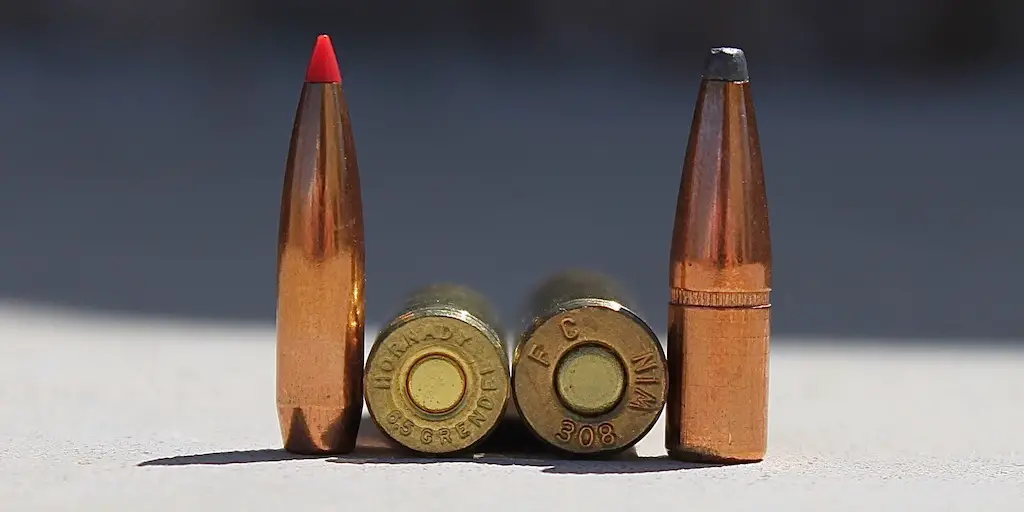
Each cartridge also uses different diameter bullets: .264″ for the Grendel and .308″ for the .308 Winchester.
Most 6.5 Grendel ammo typically has bullet weights in the 90-130 grain range, with 100 grain, 110 grain 120 grain, and 123 grain bullets being the most popular. On the other hand, the majority of .308 Winchester factory loads shoot bullets in the 110-180 grain range. 150 grain, 165 grain, 168 grain, and 180 grain bullets are by far the most common for that cartridge.
The .308 Winchester is also loaded to a higher pressure than the 6.5 Grendel (62,000psi vs 52,000psi).
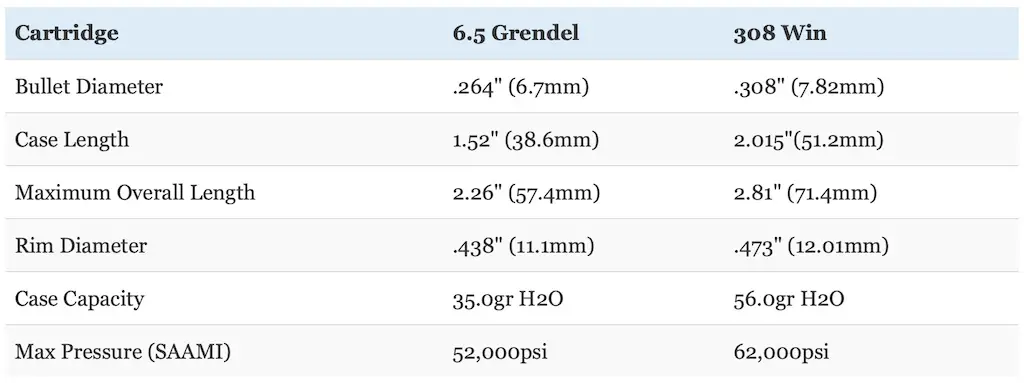
6.5 Grendel vs 308 Ballistics
Those differences in the external dimensions of the 6.5 Grendel and .308 Winchester translate into some interesting differences in their ballistic performance.
This is illustrated in the table below comparing Federal, Hornady, and Nosler factory ammunition. The 6.5 Grendel loads use a 120gr Soft Point (.340 BC), 120gr Ballistic Tip (.458 BC), and a 123gr SST (.510 BC) while the .308 Winchester loads use a 150gr Soft Point (.414 BC), a 125gr Ballistic Tip (.366 BC), and a 165gr Ballistic Tip (.475 BC).
All six loads used a 200 yard zero.
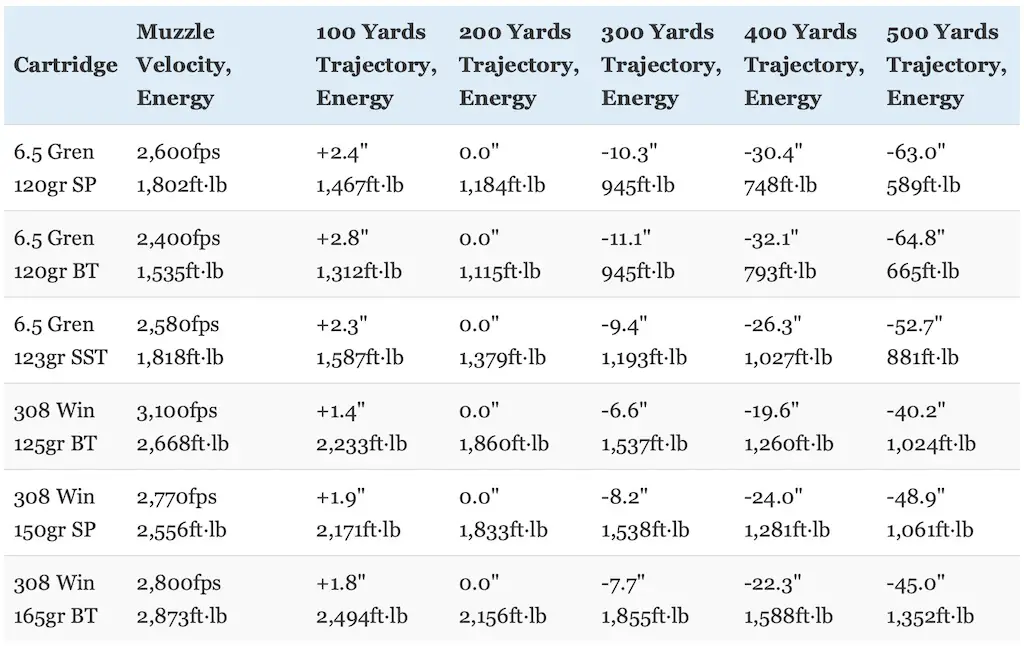
As you can see, the significantly larger case capacity of the .308 Winchester means that cartridge can push a heavier bullet at a faster muzzle velocity than the 6.5 Grendel. Not surprisingly, this gives the cartridge an edge in terms of kinetic energy and trajectory.
In this particular case, the .308 Winchester starts off with significantly more (40-87%) kinetic energy and that number increases with range for some of those loads. This is due to the fact that these particular .308 Winchester loads use a heavier bullet fired at a faster muzzle velocity.
Additionally, these .308 Winchester loads have a flatter trajectory (less bullet drop) at all ranges.
Note that the 123gr Hornady SST load bucks this trend to a certain degree. That particular 6.5 Grendel load uses a very aerodynamic bullet with a high ballistic coefficient that retains energy very well. So, while the .308 Winchester still has less drop and more retained energy at 500 yards, the gap narrows considerably with that 6.5 load.
The chart below compares how much a 10 mile per hour crosswind impacts those same 6.5 Grendel and .308 Winchester loads out to 500 yards.
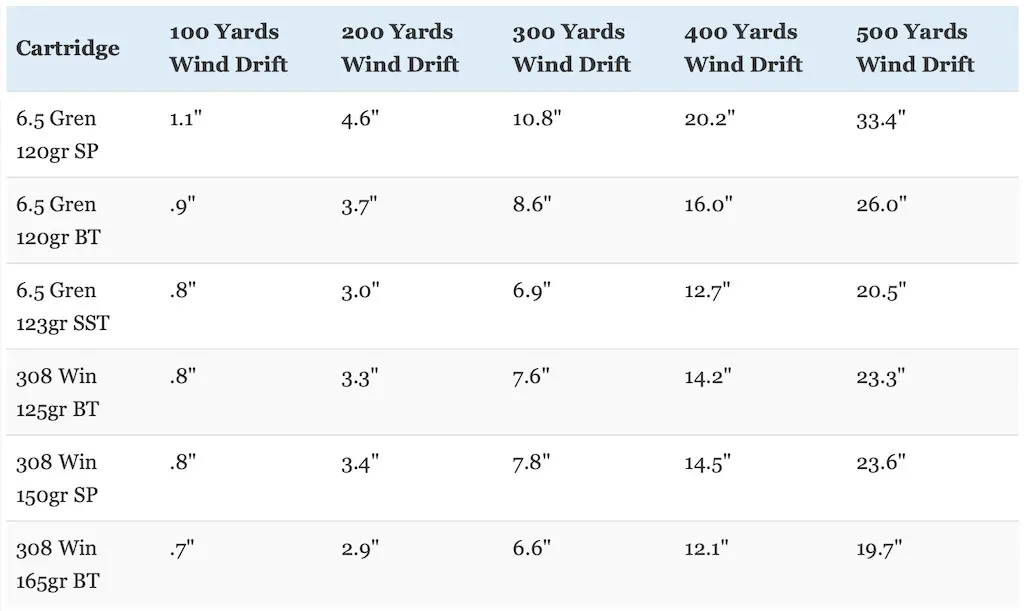
Once again we see that, with the exception of the 123gr SST load, the .308 Winchester outperforms the 6.5 Grendel in terms of wind drift at all ranges. However, the gap between the two cartridges is not as big in this particular area.
In fact, that Hornady load actually has less wind drift than some of the .308 Winchester hunting loads at all ranges. So, while the .308 Winchester does have something of an edge with wind drift, this is absolutely a strong suit for the 6.5 Grendel and the exact loads being compared here really make a big difference.
The table below compares the recoil produced by very similar loads to the ones compared above for each cartridge when fired from identical rifles.
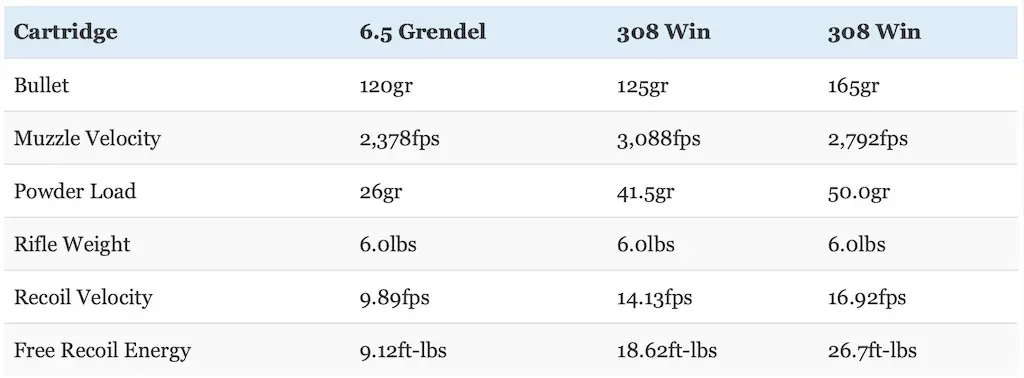
Felt recoil will vary from shooter to shooter and rifle to rifle, but free recoil energy is still a useful way to compare cartridges.
As you can see, the 6.5 Grendel has significantly less recoil than the .308 Winchester. Depending on the exact load, the .308 Winchester has approximately 2-3x more recoil! That’s really saying something too because the .308 isn’t known as an especially hard recoiling cartridge.
Most shooters should be able to handle the recoil of both cartridges, but the 6.5 Grendel has a big advantage in this respect, especially for smaller or recoil shy hunters.
Don’t underestimate the impact that recoil has on the ability of a person to shoot accurately either. Some people do handle recoil better than others, but all other things being equal, they will absolutely shoot more accurately with a milder recoiling cartridge.
So where do we stand with each cartridge?
6.5 Grendel vs 308
The .308 Winchester fires larger diameter and heavier bullets at a faster velocity than the 6.5 Grendel. For this reason, the .308 has a flatter trajectory and significantly more retained kinetic energy than the 6.5 Grendel at typical hunting ranges. However, the 6.5 Grendel has much less recoil.
When comparing these two cartridges, it’s important to remember that the 6.5 Grendel was designed to offer better performance out of an AR-15 than the .223 Remington. Bill Alexander was very successful in accomplishing that goal. However, just like there is a big gap in performance between the .223 Remington and the .308 Winchester, there remains a big (though reduced) gap in performance between the 6.5 Grendel and .308 Winchester.
All told, the 6.5 Grendel is a moderately powerful, mild recoiling, and relatively flat shooting cartridge that’s also pretty resistant to wind drift. This is especially remarkable considering that the cartridge packs that level of performance into a very small package that can still fit in the relatively tight constraints of the AR-15 platform.
This 6.5 Grendel is a very good all around cartridge for those who want to use an AR-15 for big game hunting. In addition to hunting, the 6.5 Grendel is also a really nice choice for self defense/personal protection for people who like the AR-15 platform. The cartridge also has very good barrel life.
The 6.5mm bore diameter is also in something of a sweet spot where it’s easier to manufacture very high BC bullets that’s aren’t especially heavy. Those aerodynamic projectiles don’t slow down as fast and are more resistant to wind drift.
At the same time, even though it uses lighter bullets, the 6.5 Grendel also has a slight edge over the .308 in bullet sectional density.
Sectional density (SD) is a measure of the ratio of the diameter of a projectile to its mass. All other things equal, a heavier projectile of a given caliber will be longer and therefore have a higher sectional density and consequently penetrate deeper than projectiles with a lower mass and sectional density.
As an example, 123 grain and 129 grain .264″ bullets have sectional densities of .252 and .264 respectively. This compares favorably to 150 grain, 165 grain, and 180 grain .308″ bullets which have sectional densities of .226, .248, and .271 respectively.
There’s some overlap here, but with the exception of the absolute heaviest .308 Win bullets, the 6.5 Grendel has a slight edge in sectional density. That being said, while it does have an edge in terms of sectional density, the 6.5 Grendel doesn’t “punch above its weight” to nearly the degree of cartridges like the 6.5 Swede or 9.3x62mm Mauser.
What about 6.5 Grendel vs .308 Winchester accuracy?
The .308 Winchester has seen extensive use in the hands of competition shooters and has an outstanding reputation in that area. However, the 6.5 Grendel also excels in that area as well and, if we’re being honest, both cartridges are absolutely capable of tack driving accuracy (sub-MOA, sometimes much better) in the right hands.
That said, I tend to lean toward the 6.5 Grendel in this area though because that cartridge has such mild recoil. This is a very important characteristic that absolutely helps facilitate better shot placement, which is extremely important while hunting.
On the other hand, the .308 Winchester is simply a significantly more powerful cartridge. It’s not a real heavy hitter on the level of the 7mm Remington Magnum or .300 Winchester Magnum, but it’s still in a completely different league from the 6.5 Grendel.
First, the .308 Winchester uses larger diameter bullets. Consequently, it has about 36% more frontal surface area (also known as cross sectional area) than the 6.5 Grendel (.0745 vs .0547 square inches). All other things being equal, a bigger bullet will make a bigger hole, cause more tissue damage, and result in more blood loss.
The .308 Winchester can also use significantly heavier bullets, which along with the advantage the cartridge has in case capacity, helps the .308 carry more energy downrange. Combined with the larger diameter and frontal surface area of the bullets used by the cartridge, hunters have a tiny bit more room for error in shot placement when compared to the 6.5 Grendel.
Those characteristics are also helpful when hunting larger game.
Make no mistake: 6.5 Grendel is a good hunting cartridge with outstanding terminal performance on many species of big game. It’s just that the .308 Winchester is better in that role (if the hunter can place his or her shots appropriately).
When all is said and done, the 6.5 Grendel round is still more than powerful enough for hunting varmints as well as medium sized game like deer at short to moderate range.
I’m not convinced it’s a great elk hunting cartridge though.
Watch the video below to see what I mean.
That young woman ended up killing that bull with 3 shots from her 6.5 Grendel at 390 yards using 123gr Hornady SST bullets.
At the end of the day, things turned out fine and that elk died a handful of steps from his bed. She hit the elk with all 3 shots and 2 of them (first and last) appeared to be right on the money.
That said, I think they were lucky that hunt didn’t turn into a rodeo. Elk are BIG and TOUGH animals and that looked like an especially big bull. Especially when taking a shot at 300+ yards like she did, many cartridges simply don’t have enough juice remaining to reach the vials after punching through the thick muscles and heavy bone of a big bull elk.
In my humble opinion, it would have been a much better idea to use a larger and more powerful cartridge with better terminal ballistics on that elk. The .308 Winchester would have been a better choice, but I personally would have preferred using a 7mm Magnum, a .30-06, or a .300 Win Mag.
308 Winchester vs 6.5 Grendel Ammo
While the 6.5 Grendel is a reasonably popular cartridge, it cannot hold a candle to the .308 Winchester, which is typically one of the 3 most popular cartridges in the USA. That said, there are some good factory ammo choices for both cartridges.
The big ammunition manufacturers like Barnes, Browning, Federal Premium, Hornady, Nosler, Remington, and Winchester all produce a variety of quality .308 Win factory ammunition suitable for hunting.
On the other hand, 6.5 Grendel is available from Federal with their Fusion MSR and American Eagle lines and Hornady with their American Gunner, Black, and Custom lines.
Alexander Arms still produces 6.5 Grendel ammo and Wolf also offers a pretty good low priced full metal jacket (FMJ) option for the cartridge. Nosler also offers 6.5 Grendel ammunition as part of their Ballistic Tip line.
During normal times, it’s usually very easy to find .308 Winchester ammo and almost any gun or sporting goods store will have a wide variety of .308 ammo in stock. However, while it’s not exactly rare, not every sporting goods store keeps 6.5 Grendel ammo in stock.
Availability of ammunition is usually pretty good online and the bigger retailers typically have a good selection of quality factory ammo for both cartridges in stock.
BUY SOME GREAT 6.5 GRENDEL HUNTING AMMO HERE
BUY SOME EXCELLENT 308 WINCHESTER HUNTING AMMO HERE
If you’d like to learn more about some of the best hunting ammunition choices for the 6.5 Grendel and 308 Winchester, read these articles:
Best 6.5 Grendel Ammo For Hunting Deer And Other Big Game
Best 308 Ammo For Hunting Deer, Elk, Feral Hogs, & Other Game
Reloading components for both cartridges are widely available, but the .308 Winchester is once again the more common of the two.
The 6.5 Grendel shoots the same .264″ bullet size that’s also used by the 6.5×55 Swede, 6.5 Creedmoor (often misspelled 6.5 Creedmore), .260 Remington, and 6.5 PRC (among others).
The .308 Winchester uses the same .308″ bullet size as the .30-30 Winchester, the .30-06 Springfield, the .300 Winchester Magnum, the .300 Ultra Magnum, and the 300 PRC.
Bullets like the Barnes LRX, TSX, TTSX, and TAC-X, the Hornady A-Max, ELD-X, GMX, InterBond, InterLock, SST, and V-Max, the Nosler AccuBond, AccuBond Long Range, Ballistic Tip, E-Tip, and Partition, and the Swift Scirocco and A-Frame (just to name a few) are options for if you want to reload the 6.5 Grendel and the .308 Winchester.

308 vs 6.5 Grendel Rifles
Once again, the .308 Winchester is a little bit more widely available than the 6.5 Grendel. However, there are a couple of good semi-automatic as well as bolt-action rifles chambered in both cartridges.
Alexander Arms manufactured the first rifles in 6.5 Grendel and continues to do so. Since then, Wilson Combat and a couple of other companies like Radical Firearms and Brenton USA have started producing modern sporting rifles chambered in the cartridge. It’s also possible to purchase a 6.5 Grendel upper receiver and convert an existing AR-15 to shoot the Grendel.
The 6.5 Grendel can use regular M16 rifle/M4 carbine magazines with a slight decrease in magazine capacity. A typical 30 round magazine will hold 26 6.5 Grendel rounds.
The Ruger American Ranch and Predator bolt action rifles are currently manufactured in 6.5 Grendel. The same goes for the CZ 527 and the Howa Mini.
The .308 Winchester is relatively common in semi-automatic sporting rifles like the AR-10 and M1A. It’s also very common in bolt guns. Of course Remington and Winchester produce their flagship Model 70 and Model 700 rifles in .308 Winchester. Additionally, the Browning X-Bolt, Kimber Hunter, Mossberg Patriot, Nosler M48, Ruger American, Ruger Hawkeye, Savage Axis, and Weatherby Vanguard are available in .308 Winchester as well.
Buy a nice 6.5 Grendel rifle here.
Buy a great .308 Win rifle here.
6.5 Grendel vs 308: Which Is Right For You?
Do you primarily hunt medium sized game like whitetail deer, feral hogs, or black bear at ranges within 200 yards? Both cartridges will absolutely get the job done if you do your part and there isn’t a gigantic difference between them ballistically inside of 300 yards.
Are you looking for the better cartridge for long range hunting for game like mule deer or pronghorn in open country where you might need to take a shot at several hundred yards? The .308 Winchester has a flatter trajectory, will drift a little bit less in the wind, and carries significantly more energy out past 200 yards.
Do you want a hunting cartridge that’s well suited for caribou, moose, elk, eland, kudu, or red stag hunting? I consider both to be a little on the light side, but the .308 Winchester is clearly the better choice for most hunters because it shoots heavier and larger diameter bullets that carry much more kinetic energy downrange.
Do you prefer to use a semi-automatic rifle for hunting or for personal defense? Both will absolutely work in this role. The 6.5 Grendel is available in the AR-15 platform, which is smaller and lighter. It also recoils less, which makes it easier to get back on target for a follow up shot. However, while the 6.5 Grendel is certainly powerful enough to get the job done, the .308 Winchester hits significantly harder and it’s the better choice for someone who wants a true “battle rifle.”
Are you looking for the perfect cartridge to use in a short barreled rifle (SBR)? Both will lose a certain amount of velocity with shorter barrel lengths, but I lean towards the 6.5 Grendel here. It performs closer to its full potential with a shorter 16-18 inch barrel and loses less velocity than the .308 Winchester.
Are you sensitive to recoil and in need of a serious low recoil cartridge? The 6.5 Grendel has significantly less recoil than the .308 Winchester, especially in a lighter rifle.
Do you want the round that is best suited for target shooting out past 400 yards or so in a precision rifle? Both will work and have excellent reputations for precision shooting, but I’d lean towards the 6.5 Grendel for work at longer ranges since it has such mild recoil.
As I’ve stated several times in this article, the 6.5 Grendel and the .308 Winchester are both solid rifle cartridges. However, since they were designed with very different goals in mind, the differences between them (6.5 Grendel vs 308) is pretty big in many respects. Carefully evaluate your needs as a hunter based upon the circumstances you foresee using the cartridge in, get a good hunting rifle chambered in the cartridge you select, learn to shoot it well, use quality bullets, and it should serve you well afield.
NEXT: BEST 6.5 CREEDMOOR AMMO FOR HUNTING ELK, DEER, & OTHER BIG GAME
Enjoy this article comparing the 6.5 Grendel and .308 Winchester cartridges? Please share it with your friends on Facebook and Twitter.
The Lyman 50th Edition (p181-182, 241-245) and Hornady 10th Edition (p301-304, 474-484) reloading manuals were used as references for the history of the cartridges. I obtained the data used to compare the trajectory of the cartridges from Federal (here and here), Hornady, and Nosler (here, here, and here). Data used to calculate recoil was obtained from Nosler (here and here). Case capacities were obtained from Chucks Hawks and Kwk. Maximum pressure obtained from SAAMI (p23 & 31). I used ShootersCalculator.com to compare trajectory and recoil for the cartridges.
Make sure you follow The Big Game Hunting Blog on Facebook, Instagram, Twitter, and YouTube.
John McAdams is a proficient blogger, experienced shooter, and long time hunter who has pursued big game in 8 different countries on 3 separate continents. John graduated from the United States Military Academy at West Point and is a veteran of combat tours with the US Army in Iraq & Afghanistan. In addition to founding and writing for The Big Game Hunting Blog, John has written for outdoor publications like Bear Hunting Magazine, The Texas State Rifle Association newsletter, Texas Wildlife Magazine, & Wide Open Spaces. Learn more about John here, read some of John’s most popular articles, and be sure to subscribe to his show: the Big Game Hunting Podcast.


I have seen many bull elk hit the dirt and many of them took several shots with much more powerful rounds than a 308. They are just simply tough animals. If anything I am more impressed by the 6.5 grendel after watching the video. I nearly had a large bull get away after 3 rounds from a 270 wsm. Hopefully I won’t have the same problem with my new 300 PRC
Great article! However, I would like to nit-pick a statistic: I have both an AR10 in 308 and a couple of AR15s (one in 5.56 and one in 300 Blackout). Your weight comparison states both weigh 6 pounds. My AR 10 is at least two pounds heavier than my AR15s. The difference is even greater when both have full magazines loaded. (30 rds and 25 rds respectively)
Hi Bob. You’re right about the weight difference in those rifles. That said, I intentionally compare recoil with the same weight rifle to give readers an idea of what the relative recoil is of each cartridge. Run those numbers with a 6 pound 6.5 Grendel and an 8 pound 308 and the free recoil energy differential does indeed get a lot smaller.
Is the 6.5 Grendel sufficient for pig hunting? I am considering a Grendel for the multi-faceted nature of it. That said I have had pigs disappear into the bush after being hit with a 5.56 which leads me to take a look at a caliber like the 458 SOCOM.
Thoughts on the pros and cons? Perhaps I just need two different upper, one for deer and one for pigs.
The 6.5 Grendel is a really good cartridge for deer and hogs. The 458 SOCOM definitely hits harder, but the 6.5 Grendel has a much longer effective range and is still plenty powerful (and is a BIG step up in power over the 223/556).
TullAmmo or Wolf Ammo? What happened to BUY AMERICAN? I hear and see folks buy both because, “it’s cheap” then talk about, “Buy American”? What’s up with that?